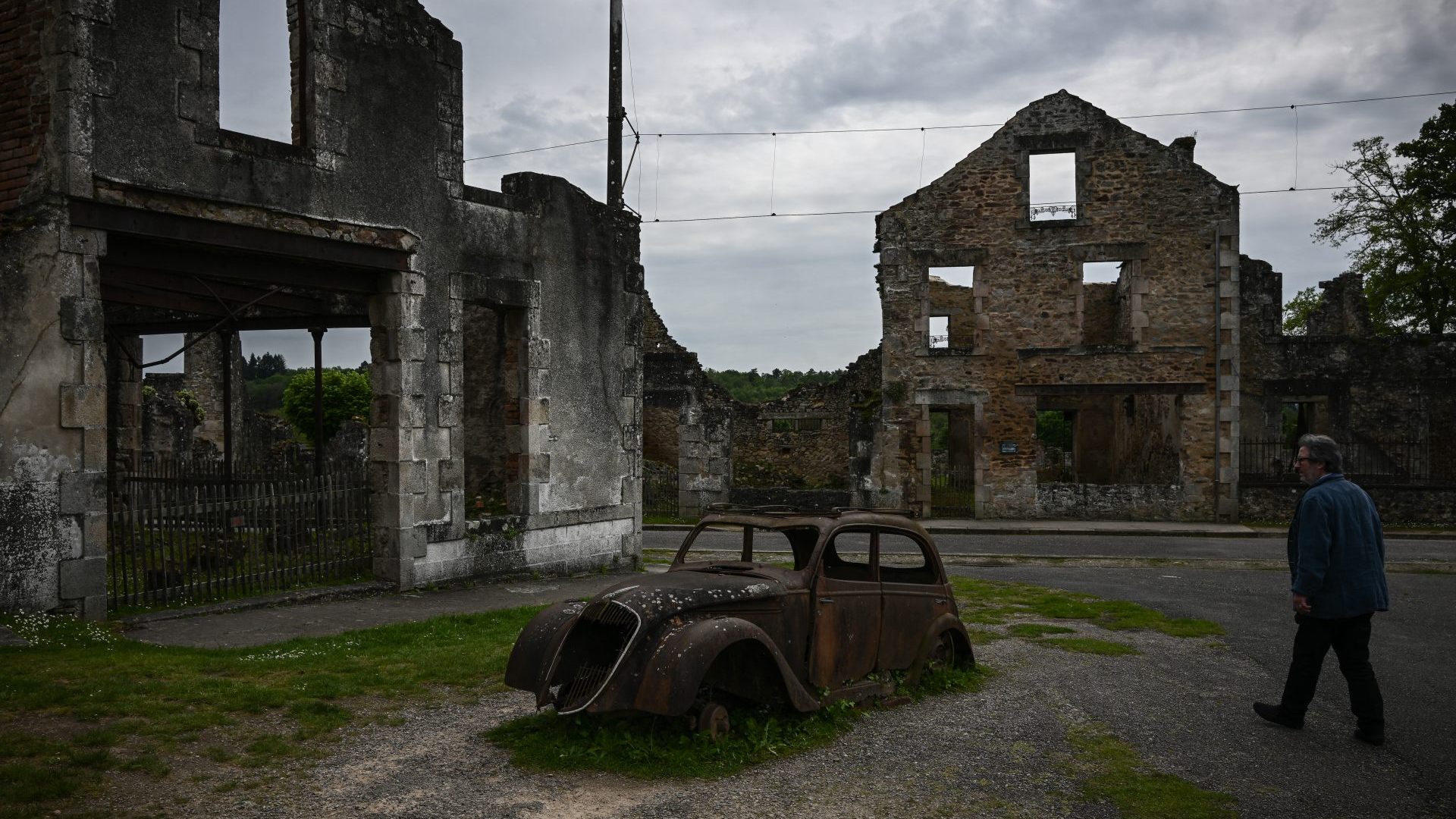From the tables outside the boulangerie in modern-day Oradour-sur-Glane you can almost see the ruins of the old village where the Nazis massacred 643 people.
A road separates the reconstructed post-war town from the site of the most notorious Nazi atrocity in occupied France, but the crumbling remains of the older place underpin everything that happens here.
When locals head off to work, school or an evening out in nearby Limoges, they can hardly avoid the scarred remnants of a place forever synonymous with a monstrous act carried out by SS troops hellbent on merciless revenge.
They see it most days through their car windows. The main street is called the Avenue du 10 Juin.
On that date in 1944, the Das Reich company marched into Oradour with the intention of murdering everyone in the village as collective punishment for local Resistance activity.
Men were brought into barns where they were shot in the legs and doused with gasoline before the barns were incinerated.
Women and children, meanwhile, were herded into a church that was set on fire. When some tried to escape through windows they were machine-gunned.
After slaughtering so many innocent civilians, the Nazis burned down the town.
It was inhumane act of vengeance, designed to wipe Oradour forever off the map.
Today, the proximity of the ruins to the small satellite town that the new Oradour has become creates an unsettling juxtaposition, one which people in this part of the Haute Vienne region have become accustomed to.
The ruins of Oradour have deliberately been left exactly as they were when the Nazis torched the village.
Under a presidential edict issued by Charles de Gaulle when he visited in 1945, Oradour, the “village of martyrs”, has been preserved as it was to remain “the symbol of the suffering of the French people during the occupation”.
As a striking visual reminder of the horrors perpetuated by fascism in Europe, there are few places quite like it.
Oradour is a time capsule for succeeding generations to walk around so that what happened – and why – is never forgotten.
Occupying such unique importance to French people, there is pressure to ensure that this hauntingly desecrated place is protected, in the same way that the Nazi concentration camps are left undisturbed.
But maintaining the fragile appearance of a settlement which the Nazis intended to erase from history represents a unique challenge.
In recent years, the erosion of the most evocative relics of the once bustling village has prompted concern.
Those involved in the preservation of the site say that without urgent action the endangered remains could collapse, an irredeemable loss which France could never replace.
Agathe Hebras, granddaughter of Robert Hebras, one of only six villagers to survive the massacre, is leading the campaign to raise at least two million euros for restoration work.
Awarded France’s highest accolade the Legion d’Honneur for a lifetime dedicated to the memory of the victims, Mr Hebras died last year aged 97.
Having spent much of her childhood travelling with her grandfather while he gave educational talks across France, Agathe is determined to continue his work.
“I am extremely concerned about the state of the village,” says Agathe. “It’s been 80 years now of conserving these ruins. So much has already disappeared, and if we don’t react very strongly and very quickly the facades that we see today will crumble.
For example, in my grandfather’s old family home, the walls have already fallen down so his childhood bed, which had been left just was it was, is covered with stones.
“Without the physical structures of the ruins, it will be harder for people to understand what happened.”
During a visit to Oradour this summer, the flow of tourists was incessant. The car park was full despite it being the first day of a heatwave.
We stopped next to the church to talk with a woman who dabbed away tears as she remembered how her own father narrowly avoided being shot dead by the Nazis.
In the stifling heat, I paused amid murmurs emanating from ambling groups to imagine what Oradour must have been like before.
A perfectly self-contained village with every amenity, with a tramway now grassed over which used to connect it with Limoges, with several bars, a hotel and shops serving every possible need.
You see children’s prams, the metal skeleton of a shop’s scales, the blackened frames of Citroen and Renault cars in the mechanic’s yard. The church bell which melted in the inferno lies on the stone floor.
Physical objects like these make Oradour such a hauntingly arresting place. It transcends a museum or an excavated ruin because there are reminders of modernity throughout. I noticed the kerbstones, so intact that were it not for the dilapidated state of the main street one could be standing in any modern town.
Life is frozen as it was 80 years ago.
“Seeing how normal life suddenly stopped,” continues Agathe, “things like a pot left on a stove, is extremely important, and invokes a lot of emotion for visitors.
“If the ruins continue to degrade, we will not be in a position to explain to people that this was where a massacre occurred. Young people in particular will struggle to visualise it. By preserving the whole area, leaving it intact, visitors can perceive how the whole population of a village was wiped out in a single afternoon.”
While the fundraising project was launched earlier this year, Oradour found itself the subject of perhaps less welcome attention in summer’ssnap parliamentary elections.
In the first round, Sabrina Minguet, the candidate for Marine Le Pen’s Rassemblement National party, obtained nearly 40% in Oradour, with 567 votes. She was beaten in the final round by Stéphane Delautrette of the Union of the Left, bt only by 54% to 46%.
Many of her supporters in the commune of just over 2,000 residents were elderly, and, like Agathe, descended from people who lost many family members in the massacre.
Those who backed Le Pen and her protégé Jordan Bardella obviously saw no parallels between their policies and the march of fascism across Europe in the 1930s.
One might have thought that the proximity of the village of martyrs might cause the current citizens to think twice about the far right. Not so, according to the results.
Proof, if it were needed, that future generations might fail to fully understand the lessons of Oradour if its physical structures are allowed to disintegrate.










